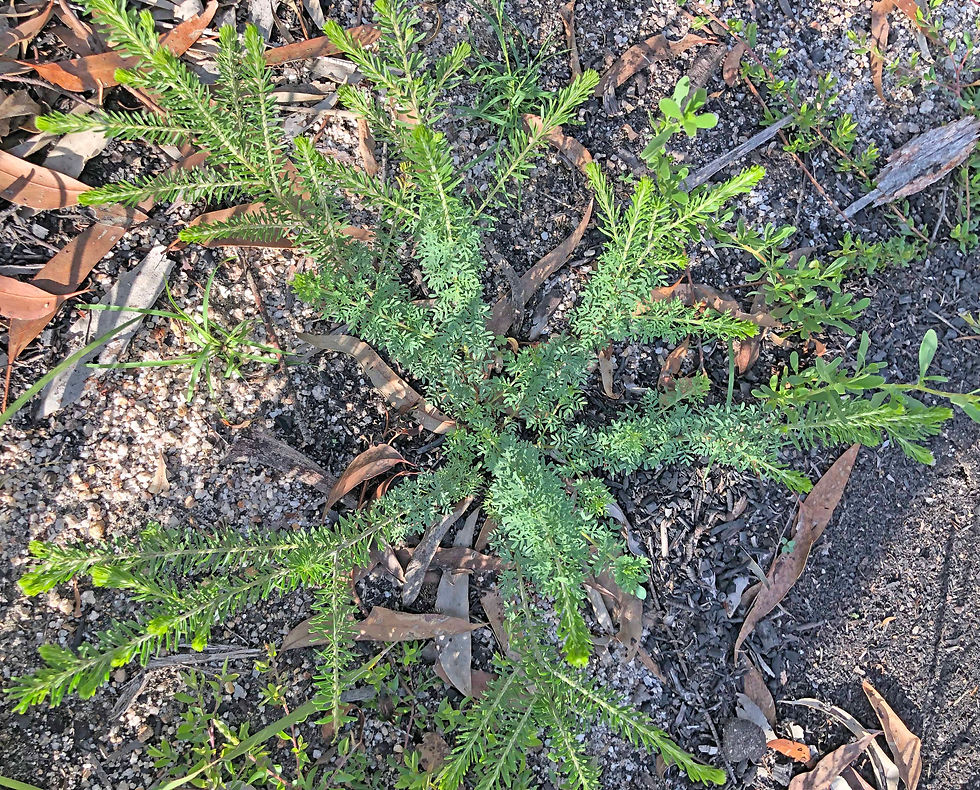
Girraween National Park: Dr Roberts Waterhole track and across Pyramids Road
Burnt February 2019
Photographed early March 2020 - 13 months after fire
Click image once to expand photos and read about their content

Looking down the track to Dr Roberts Waterhole. The fire has scorched the tree trunks but not the canopy. Ground layer plants are coming back.

Many grasses and sedges regenerate from well-established roots. These species form the backbone of open grassy communities. When a fire comes through, the thick thatch generated by these plants is removed, making space for smaller species.

This big yellow daisy (Coronidium oxylepis subsp. lanatum) really stood out. Seeds of grassland herbs that flower after fire can germinate and grow without having to compete with the thick grass cover that develops in later post-fire years.

Another, smaller daisy (Brachyscome microcarpa). Many plants of this species were flowering across the open plain.

This delicate Dwarf Boronia (Boronia poligalifolia) usually flowers in spring and summer, but produced a single autumn flower.

We spotted this tiny Horned Midge Orchid (Genoplesium sagittiferum) next to the track; it had just finished flowering and was making fruits. The year or two after a fire is a good time to look for orchids, as many species flower then.

This toadstool peeking out from under a burnt log was one of several types of fungal fruiting bodies growing up from the ashes. Some fungi fruit most profusely after a fire.

Across Pyramids Road we found this little wattle (Acacia ruppii). I am pretty sure this plant is resprouting from pre-fire roots. Towards the end of the shoots you can see its usual foliage of short, flat phyllodes (a phyllode is a stem that acts like a leaf). Around the centre are the juvenile, true leaves. This wattle is listed as endangered under the Commonwealth Government’s EPBC Act.

Another wattle (Acacia adunca). This plant is probably a post-fire seedling - I have seen this species regenerating from seed after other fires at Girraween. Again, you can see the feathery juvenile foliage. The adult phyllodes are starting to form at the end of the shoots: they are long and thin with a cute little hook at the end.

While most of the trees in Girraween are fire-tolerant eucalypts, the native Black Cypress Pine (Callitris endlicheri) is also common. Individuals of this species will die if their leaves are 100% scorched. So it has strategies to avoid that happening. One trick is the ability to grow on rock platforms, like the one in this photo, where fuel load stays relatively low and fire may not penetrate. It’s worked for these pines, and not for the first time: this area also burnt in 2014.

This Tree Trigger Plant (Stylidium laricifolium) isn’t a tree, it’s a small shrub. That, however, is enough to make it different to most Trigger Plants, which are herbs. It usually flowers in spring.

One more daisy, Yellow Buttons (Chrysocephalum apiculatum). There were other herb species flowering, too. Some are hard to photograph, like the native Bluebells (Wahlenbergia species), with their sky-blue flowers at the end of long, thin stalks.